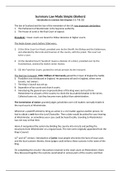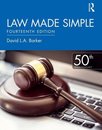Summary Law Made Simple (Barkers)
introduction to common law (chapters 1-5, 7-8, 12)
The law of Scotland and the law of the remainder of the UK; two important similarities:
1. The Parliament at Westminster is the Supreme authority.
2. The House of Lords is the final Court of Appeal.
Precedent = lower courts are bound to follow decisions in higher courts.
The Anglo-Saxon courts before 1066 were:
3. (i) the Shire Court (or Moot), presided over by the Sheriff, the Bishop and the Ealdorman,
and attended by the lords and freemen of the county, with the priest. This court sat
twice a year;
4. (ii) the Hundred Court (‘hundred’ means a division of a shire), presided over by the
Hundredman, assisted by twelve senior thanes;
5. (iii) the Franchise Courts, granted to certain persons by the monarch.
The Norman Conquest: 1066: William of Normandy gained the Crown of England by battle.
6. Feodalism was introduced in England. He possessed all land in England, others were
tenants, not owners.
7. The King’s Council was set up.
8. Separation of lay courts and church courts.
9. Introducing the general eyre (representatives of the king were sent out from
Westminster to all parts of the country to check the local administration in the shires.
Collected taxes etc., but they became more judicial than administrative.
The Commission of Azzize: granted judges jurisdiction over civil matters normally triable in
the royal courts at Westminster.
Whenever a plaintiff wished to bring an action in a civil matter against another person, he
had to obtain a writ form the Lord Chancellor. Then a date would be picked for your hearing
at Westminster, or sometimes your case could be heard locally, traveling to Westminster
was not easy at that time.
Henry II reorganized the system by dividing the country into circuits and putting the
excursions form Westminster on a regular basis. The men were originally appointed from the
King’s Council.
12th and 13th century: introduction of juries: local people who knew the facts of local cases
and the local customs thereto, these judges could enforce these customs in the name of the
King.
On completing the circuits> the justices returned to the royal courts at Westminster, there
they discussed together the customs ascertained in various parts of the country and their
,findings. They rejected those that were unreasonable and accepted those that were not, by
the use of good sense and right reason they formed a uniform pattern of customary law
throughout England.
At the same time judges began to apply the principle of stare decisis (let the decisions
stand). Law became more certain and predictable. = common law of England (so called
because it is the law common to all parts of England and Wales).
King’s Council = curia regis = central government of the Kingdom.
The Court of the Exchequer (Henry I, national revenue, collecting taxes, disputes over taxes,
Barons of the Exchequer)
The Court of Common Pleas (disputes between persons over land)
The Court of the King’s Bench (The King himself sat in this too, jurisidiction over criminal
matters, civil cases, supervisory jurisdiction over the activities of all inferior courts.
Provisions of Oxford 1258: forbade the practice of creating new writs > State of
Westminster II 1285: empowered to issue writs in consimili casu (in like case to). Still it did
not meet the satisfaction of the people. The common law did not expand to meet the urgent
and growing needs of the community > equity.
Equity: that body of rules originally enforced only by the Court of Chancery.
Petitions of persons unable to obtain justice in the common law courts were sent to the Kind
as fountain of justice. Later the petitions were sent to the Chancellor, who dealt with them
alone.
End of the 15th century: The Chancellor had set up a separate court that dealt with petitions
for relief. The Chancery court was popular among the people and jurisdiction was lost to the
Chancery Court, instead of the common law courts. Sometimes both courts used
contradictory verdicts, relations between these two became difficult.
The dispute between the two courts came to a head under James I in the Earl of Oxford’s
case (1616). The advocate general (Sir Francis Bacon) advised that where common law and
equity conflicted, equity should prevail.
Matters where finally resolved by the passing of the Judicature Acts 1873-5.
John Selden: common law was predictable; equity is uncertain and not predictable, because
it is based on conscience.
,Lord Nottingham: equity should be administered where possible in accordance with known
principles and not by arbitrary discretion. Only where there was no precedent or where
there was conflict in the rules or principles, should conscience determine the matter.
With the adoption of the system of precedents, equity became predictable and intelligible.
Lord Eldon: further developed equity, establishing a system of case law, so that by the
beginning of the 19th century equity became nearly as rigid as the common law.
In the 19th century there was much delay in the equity law, mostly because of the workload
of the Lord Chancellor. The latter half of the 19th century was a period of judicial reform:
Judicature Acts 1873-5: new structure of courts: Supreme Court of Judicature + 4 new
principles:
1. Equity and common law should in future be administered side by side in all courts
2. Where there is conflict, the rule of equity should prevail.
3. Evidence should be given in court orally
4. Rules of the Supreme Court of Judicature were to be formulated with regard to
procedural matters.
‘Who comes to equity, must come with clean hands’.
Give King money in exchange of change in law.
Commons = knights and freemen from cities, boroughs and the shires.
Royalists = supporting the King
Parliamentarians = supporting the Commons
Bill of Rights 1689: King could not in the future override Acts of Parliament or exercise great
powers of government without check from the representatives of Parliament.
King called Parliament together at least once a year, because the Commons would grant
money to the King for one year only.
Britain today is a constitutional monarchy.
Nineteenth century:
The Judicature Acts 1873-5 set up a Supreme Court of Judicature compromising: the Court
of Appeal and the High Court of Justice.
The High Court of Justice includes:
the Queen’s Bench division
The Chancery division
The Common Pleas division
The Exchequer division
, The Probate, Divorce and Admiralty division
Order in Council under the Judicature Acts 1873-5: The Common Pleas and Exchequer were
merged into the Queen’s Bench division, forming three division that lasted till 1970.
- The Queen’s Bench division
- The Chancery division
- The Probate, Divorce and Admiralty division
Eventually the House of Lords was replaced by a Supreme Court being the court of appeal.
The relevant statute is now the Supreme Court Act 1981, which has replaced earlier
legislations.
Legal sources of English law: judicial precedents, legislation, certain ancient textbooks, local
custom (to a very limited extent).
The system of binding precedent occurred.
Court of Justice of the European Communities
Supreme Court (replaced the House of Lords, bind all other courts but not necessarily the
Supreme Court itself).
Court of Appeal (civil division, binds the High Court, county courts and divisional courts and
itself)
Court of Appeal (criminal division, binds the Crown Court and the magistrate’s courts, and
probably bind the Queen’s Bench divisional court.
Queen’s Bench divisional Court (bind the magistrates courts but not the Crown Courts and
normally the court follows its own decisions).
High Court (decisions of its judges do not bind other High Court judges, but they bind county
court judges)
Overruling occurs where a higher court (e.g. the Supreme Court) decides a similar case on
the basis of a different legal principle. The previous rule laid down (e.g. by the Court of
Appeal) is then said to be overruled.
Reversal occurs where an appeal court reverses a decision given in a lower court from which
the appeal emanated. Thus, in the case of A v B a High Court may give judgment for A, while
on appeal the higher court gives judgment for B.






